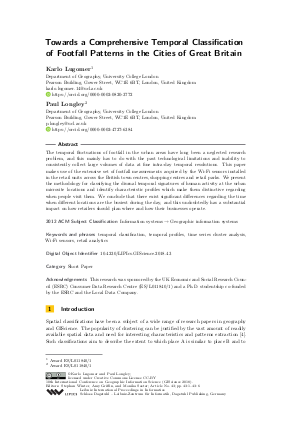Towards a Comprehensive Temporal Classification of Footfall Patterns in the Cities of Great Britain (Short Paper)
Authors
Karlo Lugomer  ,
Paul Longley
,
Paul Longley 
-
Part of:
Volume:
10th International Conference on Geographic Information Science (GIScience 2018)
Part of: Series: Leibniz International Proceedings in Informatics (LIPIcs)
Part of: Conference: International Conference on Geographic Information Science (GIScience) - License:
 Creative Commons Attribution 3.0 Unported license
Creative Commons Attribution 3.0 Unported license
- Publication Date: 2018-08-02
File

PDF
LIPIcs.GISCIENCE.2018.43.pdf
- Filesize: 316 kB
- 6 pages
Document Identifiers
Subject Classification
ACM Subject Classification
- Information systems → Geographic information systems
Keywords
- temporal classification
- temporal profiles
- time series cluster analysis
- Wi-Fi sensors
- retail analytics
Metrics
- Access Statistics
-
Total Accesses (updated on a weekly basis)
0Document
0Metadata
Abstract
The temporal fluctuations of footfall in the urban areas have long been a neglected research problem, and this mainly has to do with the past technological limitations and inability to consistently collect large volumes of data at fine intra-day temporal resolutions. This paper makes use of the extensive set of footfall measurements acquired by the Wi-Fi sensors installed in the retail units across the British town centres, shopping centres and retail parks. We present the methodology for classifying the diurnal temporal signatures of human activity at the urban microsite locations and identify characteristic profiles which make them distinctive regarding when people visit them. We conclude that there exist significant differences regarding the time when different locations are the busiest during the day, and this undoubtedly has a substantial impact on how retailers should plan where and how their businesses operate.
Cite As Get BibTex
Karlo Lugomer and Paul Longley. Towards a Comprehensive Temporal Classification of Footfall Patterns in the Cities of Great Britain (Short Paper). In 10th International Conference on Geographic Information Science (GIScience 2018). Leibniz International Proceedings in Informatics (LIPIcs), Volume 114, pp. 43:1-43:6, Schloss Dagstuhl – Leibniz-Zentrum für Informatik (2018)
https://doi.org/10.4230/LIPIcs.GISCIENCE.2018.43
BibTex
@InProceedings{lugomer_et_al:LIPIcs.GISCIENCE.2018.43,
author = {Lugomer, Karlo and Longley, Paul},
title = {{Towards a Comprehensive Temporal Classification of Footfall Patterns in the Cities of Great Britain}},
booktitle = {10th International Conference on Geographic Information Science (GIScience 2018)},
pages = {43:1--43:6},
series = {Leibniz International Proceedings in Informatics (LIPIcs)},
ISBN = {978-3-95977-083-5},
ISSN = {1868-8969},
year = {2018},
volume = {114},
editor = {Winter, Stephan and Griffin, Amy and Sester, Monika},
publisher = {Schloss Dagstuhl -- Leibniz-Zentrum f{\"u}r Informatik},
address = {Dagstuhl, Germany},
URL = {https://drops.dagstuhl.de/entities/document/10.4230/LIPIcs.GISCIENCE.2018.43},
URN = {urn:nbn:de:0030-drops-93718},
doi = {10.4230/LIPIcs.GISCIENCE.2018.43},
annote = {Keywords: temporal classification, temporal profiles, time series cluster analysis, Wi-Fi sensors, retail analytics}
}
Author Details
- Department of Geography, University College London, Pearson Building, Gower Street, WC1E 6BT, London, United Kingdom
Funding
- Lugomer, Karlo: Award ES/L011840/1
- Longley, Paul: Award ES/L011840/1
References
-
Anthony Bagnall, Eamonn Keogh, Stefano Lonardi, Gareth Janacek, et al. A bit level representation for time series data mining with shape based similarity. Data Mining and Knowledge Discovery, 13(1):11-40, 2006.

-
Anthony Bagnall, Jason Lines, Aaron Bostrom, James Large, and Eamonn Keogh. The great time series classification bake off: a review and experimental evaluation of recent algorithmic advances. Data Mining and Knowledge Discovery, 31(3):606-660, 2017.

-
Christopher G Gale, A Singleton, Andrew G Bates, and Paul A Longley. Creating the 2011 area classification for output areas (2011 oac). Journal of Spatial Information Science, 12:1-27, 2016.

-
Maria Halkidi, Yannis Batistakis, and Michalis Vazirgiannis. On clustering validation techniques. Journal of intelligent information systems, 17(2-3):107-145, 2001.

-
Anil K Jain, M Narasimha Murty, and Patrick J Flynn. Data clustering: a review. ACM computing surveys (CSUR), 31(3):264-323, 1999.

-
T Warren Liao. Clustering of time series data—a survey. Pattern recognition, 38(11):1857-1874, 2005.

-
Karlo Lugomer, Balamurugan Soundararaj, Roberto Murcio, James Cheshire, and Paul Longley. Understanding sources of measurement error in the wi-fi sensor data in the smart city. In Proceedings of the 25th GIS Research UK (GISRUK) Conference, Manchester, UK, April 18-21, 2017, 2017.

-
Pablo Montero, José A Vilar, et al. Tsclust: An r package for time series clustering. Journal of Statistical Software, 62(1):1-43, 2014.

-
Roberto Murcio, Bala Soundararaj, and Karlo Lugomer. Movements in cities: Footfall and its spatio-temporal distribution. In Paul Longley, James Cheshire, and Alex Singleton, editors, Consumer Data Research, chapter 6, pages 85-96. UCL Press, London, 2018.

-
Mark A Newell, Dianne Cook, Heike Hofmann, and Jean-Luc Jannink. An algorithm for deciding the number of clusters and validation using simulated data with application to exploring crop population structure. The Annals of Applied Statistics, pages 1898-1916, 2013.

-
Jin Shieh and Eamonn Keogh. i sax: indexing and mining terabyte sized time series. In Proceedings of the 14th ACM SIGKDD international conference on Knowledge discovery and data mining, pages 623-631. ACM, 2008.

